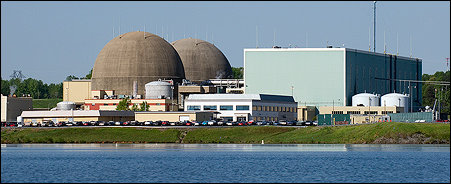
Dominion Energy may have declared a “pause” in the development of a third nuclear unit at its North Anna Power Station, but a consumer advocacy group says that’s not good enough. It’s time to shut down the project permanently.
“Dominion needs to kill North Anna to protect rate payers,” said Irene Leech, president of the Virginia Citizens Consumer Council (VCCC). Critics have estimated that the project will cost roughly $19 billion, which would make it the most expensive power plant ever built in Virginia by a factor of ten or more. “If Dominion doesn’t do it, the SCC (State Corporation Commission) should intervene.”
Leech made her comments while introducing Dr. Mark Cooper, senior fellow for economic analysis, Institute for Energy and the Environment, at Vermont Law School, in a media conference call. Cooper, who had predicted the recent cancellation of the V.C. Summer nuclear plant in South Carolina after massive construction cost overruns, filed testimony with the SCC today on behalf of the VCCC in regards to Dominion’s 2017 Integrated Resource Plan.
“Dominion’s recently announced decision to suspend development of North Anna 3 is welcome, but long overdue and not as decisive as it should be,” Cooper said. “The Commission should order North Anna 3 removed from the IRP and refuse to allow any cost recovery associated with the development of North Anna 3 other than through the normal rate-making process, in which the utility demonstrates that it is the least cost option and useful to ratepayers.”
While acknowledging that the nuclear plant is extremely expensive, Dominion has argued that the utility should preserve the nuclear option to cope with a worst-case regulatory scenario restricting carbon-dioxide emissions. In its integrated resource plan, the company explores six scenarios. In one of them, Plan H, Dominion would be have to cut carbon emissions 7% compared to a 2012 baseline by 2030, compelling the closure of up to four coal-fired units at its Mecklenburg and Clover power stations, and making it impossible to make up the lost base capacity with natural gas. The plan contemplates 5,760 megawatts of new solar capacity, but solar output is intrinsically variable. That would leaves nuclear as the only option when the sun didn’t shine, the company has said. The company would not need to build the nuclear plant under any other regulatory scenario.
While some observers assume that Dominion hit the pause button on North Anna 3 because of horrendous construction cost overruns at plants in South Carolina and Georgia, spokesman David Botkins says the company made the decision more than a year ago. Regulatory uncertainty made it prudent to put the project on hold but not to spike it. The Clean Power Plan, which orders states to impose CO2 emissions on their electric utilities, is not dead. Its legality is tied up in the federal court system, and the McAuliffe administration is moving ahead with his own low-carbon plan for Virginia. The company has not made the decision to build the nuclear unit but thinks it worthwhile, after spending roughly $600 million to obtain a Combined Operating License (COL), to keep the option open.
Given the momentum of technology, Cooper argued, there is no chance of nuclear becoming economically viable. “Nuclear construction costs escalate relentlessly, driven by complexity,” he said. “Nuclear is the most expensive way imaginable to reduce carbon emissions. It’s a bad investment. I have wind, solar, and energy efficiency in hand today at a third of the cost of North Anna 3. I want to get [nuclear] off the table.”
The United States electric system is transitioning “to flexible, small-scale, renewable, distributed” energy sources like rooftop solar. Meanwhile investments in energy efficiency and demand-management strategies are holding down growth in electricity consumption, Cooper said. The ability to store large volumes of electricity in batteries will make it possible to overcome the problem of volatile energy output.
“Think about your laptop, tablet, or cell phone. Ten years ago … the battery life was an hour. Now it’s ten hours. They’re making huge progress in energy storage,” Cooper said. Meanwhile, solar + batteries can increase generating capacity in increments rather than in one a big chunk when the nuclear plant comes online. Utilities talk about solar plants sitting idle at night or under cloudy skies. Large swaths of the electrical infrastructure, such as combustion turbine plants that run only during periods of peak demand, spend much of their time idle as well. Nuclear isn’t cost competitive now, and it never will be, he said.
Putting the North Anna 3 project on hold is not an adequate response, Cooper said. The General Assembly allowed Dominion to capture $570 million from rate payers to defray the cost of obtaining the North Anna 3 operating license. That sum has economic value. Assuming rate payers could earn 3% annually on that money, the opportunity cost amounts to almost $300 million over ten years. Even with the project on hold, said Cooper, “rate payers are bearing a burden.”
Dominion thinks of the North Anna 3 option as a form of insurance policy. “As has been shown throughout history, forecasts change over time,” says a prepared Dominion statement. “Fuel diversity is a key component of any energy plan. Our customers enjoy some of the lowest rates in the United States, due in large part, to the safe, reliable, clean and dependable nuclear units at Surry and North Anna.”
“The [Combined Operating License] is good indefinitely, and, while no decision has been made to build it, we could make a decision to move forward with it if business conditions change,” said Richard Zuercher, spokesman for Dominion Energy’s nuclear power operations. “We would not do so, however, without authorization from the State Corporation Commission.”


